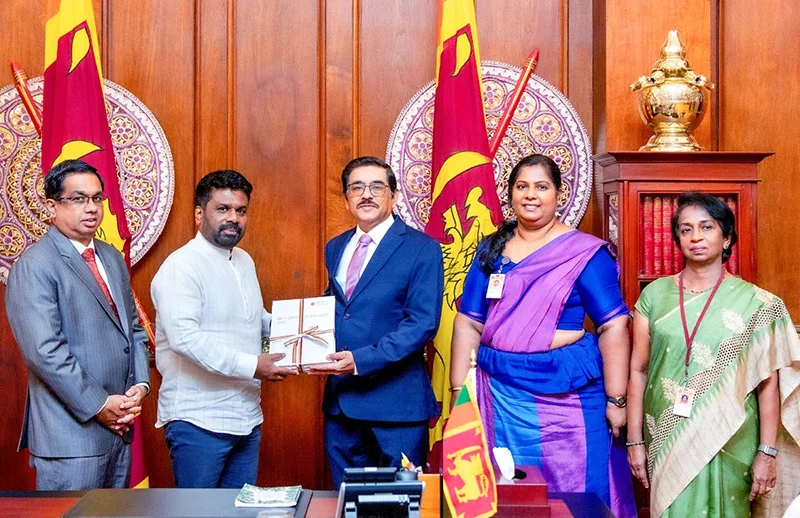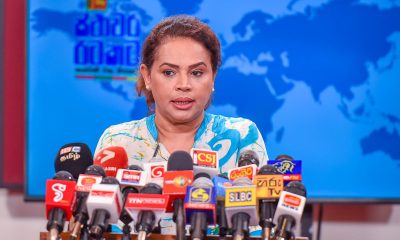Business
Tourism industry, an effective solution to SL’s economic crisis – Dr. Malraj Kiriella

By Ifham Nizam
Sri Lanka is in the grip of an economic crisis with an uncertain future looming, but the tourism industry represents one effective solution to the economic downturn, tourism expert Dr. Malraj Kiriella said.
Speaking at a public forum recently on the tourism sector in Sri Lanka, Kiriella said that tourism not only generates much-needed foreign exchange but also brings about revenue that filters down to the periphery.
The forum, a 20th round table discussion, was organized by the Gamani Corea Foundation and was held at the BMICH. The discussion centered on an issues paper on the ‘Tourism Sector’ which was authored and presented by Kiriella.
Kiriella is a multi-disciplinary expert, having over 30 years of professional work experience in the travel and tourism industry. He has worked in different capacities at senior management level in national tourism administration, research and planning, marketing and promotions, compliance and standardization, international relations and sustainable development. He is the Founder/Owner of South Asia Multidisciplinary Advisory Services (SAMAS).
Kiriella also said that the government is putting in numerous efforts to get the tourism industry off to a great start.
Kiriella added: “Tourism will be core to Sri Lanka’s future growth. The economic potential of the industry is gigantic. Without a doubt, it requires a focused and holistic approach and realistic goals in order to reach its full potential.
‘The lack of a Tourism Satellite Accounting System and documentation on direct GDP and employment from tourism underscores the urgent need for improved methods to estimate tourism’s economic impact. Sustainable practices remain largely confined to major operators, with SMEs facing barriers like funding and technology.
“The scarcity of case studies on sustainable hospitality practices hampers our understanding of effective strategies and their impacts.
“To foster change and competitiveness, collaborative efforts are vital to compile and share these case studies, encouraging broader adoption of sustainability in our industry. One critical issue is the prevalence of unregistered tourism establishments which is estimated to be more than figures relating to registered establishment rooms. This lack of formal registration hampers ability to make informed policy decisions, ensure quality control, and effectively collect taxes. We need a survey to identify barriers to registration and improve data accuracy. By understanding these obstacles, we can implement targeted measures to support both registered and unregistered establishments, fostering a more inclusive and sustainable tourism industry.
“Additionally, the lack of analysis in tourism value chain development hampers planning and management. Comprehensive research is urgently needed to understand market potential and multiplier effects, facilitating the establishment of robust frameworks for sustainable tourism growth.
“Sri Lanka’s tourism sector faces skill shortages and low women’s participation, hindering its growth. Women’s involvement is below 10%, far below global of 54% and Asia-Pacific average of 53%. Cultural barriers impede their participation, requiring intervention. Preserving resources and adapting to consumer preferences is essential. Addressing negative publicity is vital for sustainable growth and international market access.”
Speaking to The Island Financial Review, Devindre Senaratne, past president of the Sri Lanka Association of Inbound Tour Operators and chairman, Sigiriya Jungles Resort said tourism is one of the most important industries and rightly the low-hanging fruit for Sri Lanka’s economy. It is very important to make strategic decisions from all stakeholders to ensure that tourists visiting Sri Lanka from any part of the world have a pleasant stay while they are here.
Senaratne, who was one of the panelists at the forum added: “Tourism brings in a considerable amount of foreign exchange and in 2018 our best year, we had 2.3 million tourists and had a forex income of USD 4.5 billion which was the second best net foreign exchange contributor. We are very confident with the present demand patterns, we will handle approximately 2 million tourists and have an income of over USD 4.5 billion for 2024.
“Our infrastructure facilities to serve the tourists are very important for them to conveniently get about without any hassle. For example, we need to get ourselves better organized with facilities at the airport to quickly disembark without a hassle at immigration.
“Line ministries, such as, Sri Lanka Railways, Department of Wildlife and the Central Cultural Fund need to have online ticket purchasing systems to enable convenient purchasing of tickets.
“Tourist Police could be a major supporter too if they will be on the alert at major tourist sites and the popular beaches to ensure the tourists are safe. They could also advertise an emergency number.”
Business
Colombo Tea Auction: BOP struggles while lower-grade teas gain

Analysts see budget-conscious international buying amid global economic pressures
This week’s Sri Lanka tea auction recorded the highest volume since February, with total offerings reaching 6.45 million kilograms (M/Kgs). However, the market displayed a mixed performance, with high-quality Broken Orange Pekoe (BOP) varieties facing price declines while lower-end teas saw appreciation.
Select Western BOP/BOPF teas, typically among the most sought-after, dropped by over Rs. 100 per kg, while others in the category saw smaller declines. Nuwara Eliya BOPs, known for their delicate flavor were mostly unsold, and when sold, fetched up to Rs. 200 per kg less than previous levels. Uva BOPs also declined by up to Rs. 50 per kg, reflecting weaker demand for premium liquoring teas.
In contrast, teas at the lower end of the market fared better. Below Best BOPs remained steady, while BOPFs in the same category fell by Rs. 50 per kg or more, influenced by inconsistent quality. Meanwhile, Low Grown PF1s (CTC grade) saw a firmer trend, with some appreciation in value.
The Leafy and Semi-Leafy sector saw Select Best BOP1s maintain stable prices, while OP1s (Orange Pekoe) were irregular—well-made varieties eased, but others appreciated. In the Tippy segment, high-priced FBOPs dipped, but Best and Below Best grades held firm, with the lowest-end teas gaining value.
Despite price corrections, all categories met fair demand, with Low Growns dominating at 2.6 M/Kgs. The Premium catalogue showed selective firmness for very tippy teas, while others eased or declined.
Analysts suggest that the dip in high-quality teas may reflect subdued demand from key export markets, while the resilience of lower-grade teas indicates steady domestic and budget-conscious international buying.
“With global economic pressures persisting, auction trends may continue fluctuating in the coming weeks,” they said.
– Reported using data from Forbes & Walker Tea Brokers
By Sanath Nanayakkare
Business
CBSL releases publication on financial statements for 2024

The publication on the Financial Statements and Operations of the Central Bank of Sri Lanka 2024, a requirement under Section 99(2) of the Central Bank of Sri Lanka Act, No 16 of 2023, was presented to the President and the Minister of Finance, Planning and Economic Development, Anura Kumara Dissanayake, by Dr. Nandalal Weerasinghe, the Governor of the Central Bank of Sri Lanka, 29 April.
Dr. N S Kumanayake, Secretary to the President, Ms. Lasanthi Sirimanne, Chief Accountant and Ms. Samudra Jayasundera, Director Policy Review and Monitoring Department of the Central Bank were also present at this occasion.
The Financial Statements and Operations of the Central Bank of Sri Lanka 2024 present an overview of the Central Bank’s institutional performance during the year 2024. The publication is structured into three main components: Operational Insights, Financial Statements, and Supplementary Information.
The Operational Insights section outlines the Central Bank’s strategy and its core responsibilities, including maintaining domestic price stability, ensuring financial system stability, overseeing payment and settlement systems, managing currency issuance, and strategic communication. This section also covers the Bank’s international engagements, the execution of other entrusted responsibilities including agency functions, and internal management arrangements.
The Financial Statements section presents the IFRS-compliant financial statements of the Central Bank of Sri Lanka for the year ended 31 December 2024, along with the independent report of the Auditor General. This segment also includes a financial review, providing an analysis of the Bank’s financial performance during the year.
The Supplementary Information section provides details on the Bank’s regional presence, the list of institutions regulated and supervised by the Central Bank, and a summary of corporate information.
The interactive PDF of this publication can be accessed through; https://www.cbsl.gov.lk/en/publications/economic-and-financial-reports/financial-statements-operations
Business
Emirates deepens strategic partnership with Sri Lanka Tourism Promotion Bureau to support local travel industry

At the Arabian Travel Market 2025, Emirates and the Sri Lanka Tourism Promotion Bureau (SLTPB) have renewed their partnership aimed at further developing the country’s tourism and trade industries. The partnership was sealed through a Memorandum of Understanding (MoU) between the two parties.
The MoU was signed by Essa Sulaiman Ahmad, Emirates’ Senior Vice President of Commercial West Asia & Indian Ocean and Sampath Nissanka, Managing Director – Sri Lanka Tourism Promotion Bureau. The signing ceremony was also attended by Adnan Kazim, Emirates’ Deputy President and Chief Commercial Officer; Alexi Gunasekera, Consul General-designate of Sri Lanka to Dubai and the Northern Emirates in addition to other representatives of the airline and tourism board.
First inked in 2022, the renewed MoU will strengthen the collaboration between Emirates and SLTPB, with both the airline and tourism body reiterating their commitment to actively promote Sri Lanka as a destination to key markets within Emirates’ network.
Through joint initiatives, such as developing excursions and familiarization trips to promote the island nation to key feeder markets, Emirates and SLTPB aim to grow the tourism industry of the popular Indian Ocean destination by showcasing the destination to customers across the airline’s global network.
The joint efforts to boost the nation’s tourist industry have supported a steady increase in inbound traffic into the island, which recorded just over 2 million visitors in 2024. Between April 2024 and March 2025, Emirates carried over 240,000 passengers into Sri Lanka from key markets around its network including Russia, the UK, Germany, Australia, China, and the US, among others.
-

 Business4 days ago
Business4 days agoPick My Pet wins Best Pet Boarding and Grooming Facilitator award
-

 News4 days ago
News4 days agoNew Lankan HC to Australia assumes duties
-

 News4 days ago
News4 days agoLankan ‘snow-white’ monkeys become a magnet for tourists
-

 News2 days ago
News2 days agoJapan-funded anti-corruption project launched again
-

 Features4 days ago
Features4 days agoKing Donald and the executive presidency
-

 Business4 days ago
Business4 days agoACHE Honoured as best institute for American-standard education
-

 Features6 days ago
Features6 days agoThe Truth will set us free – I
-

 Business2 days ago
Business2 days agoNational Savings Bank appoints Ajith Akmeemana,Chief Financial Officer














